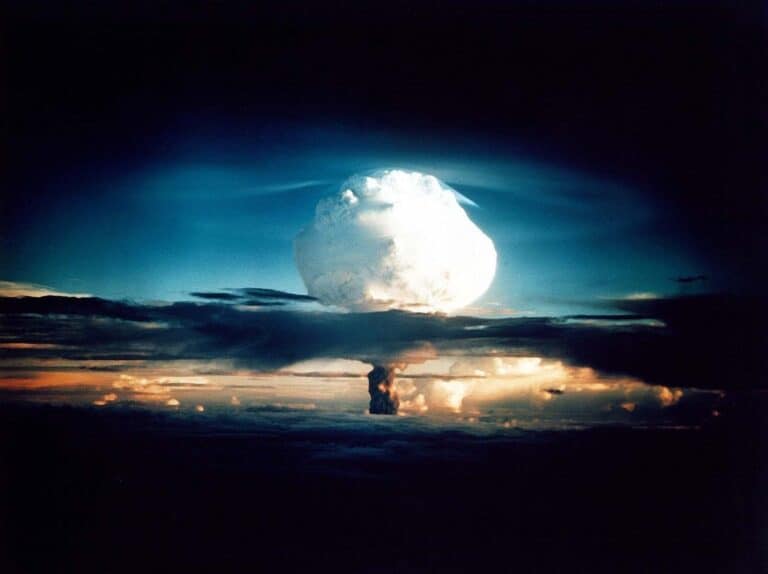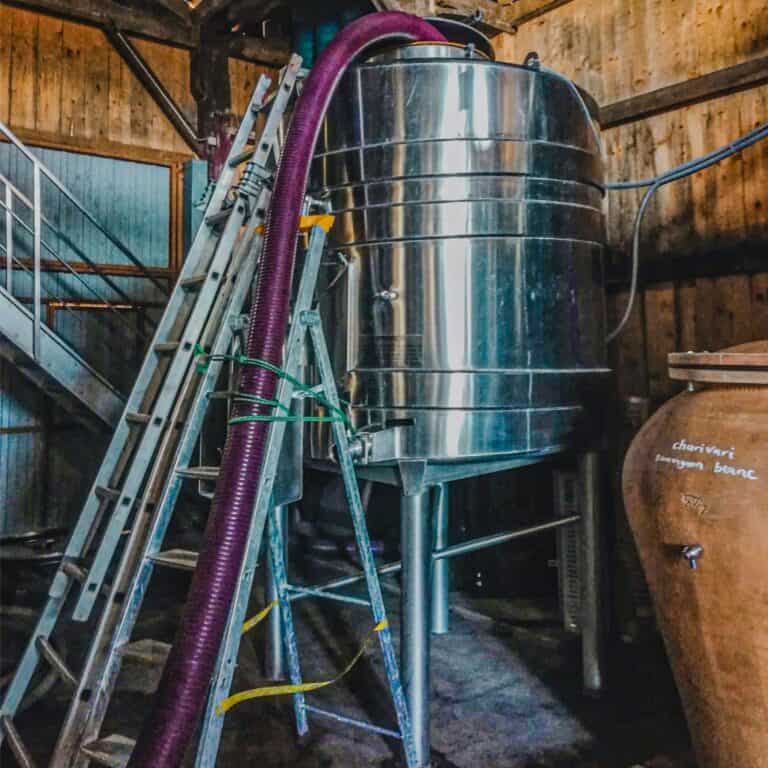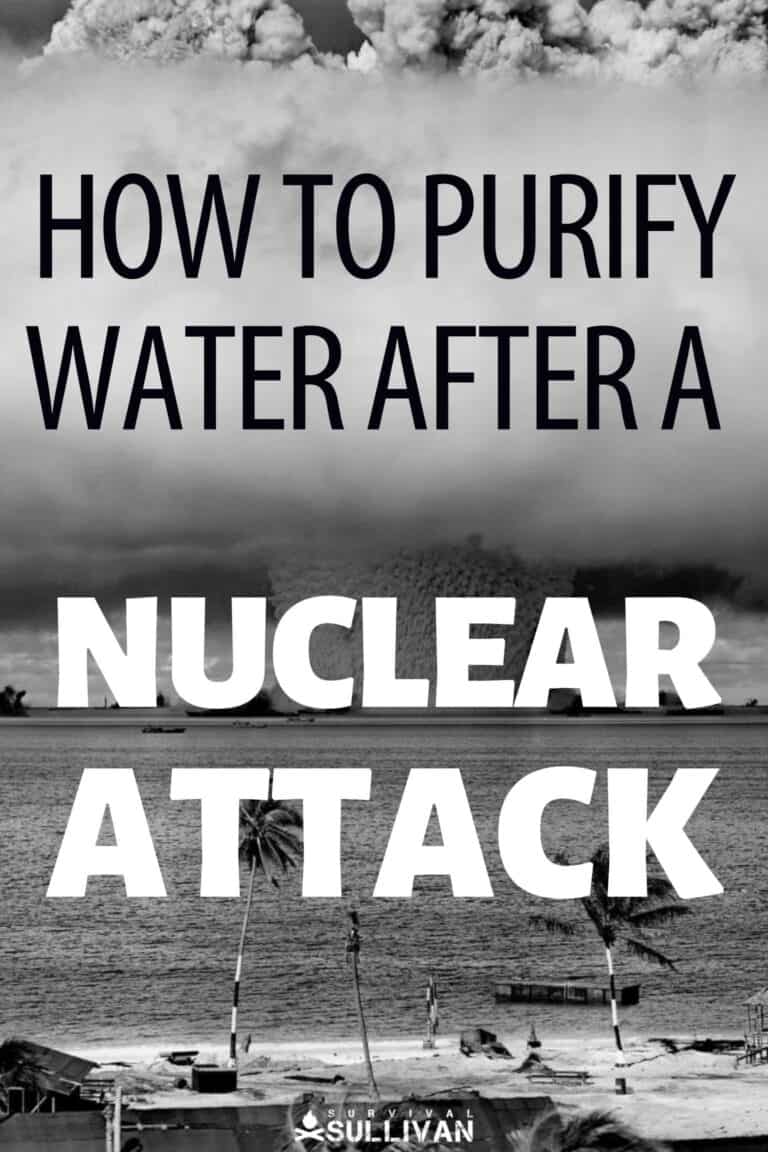Water is essential for human life, but after a nuclear attack or nuclear accident, the water can become contaminated with radioactivity, either directly or through inundation with radioactive debris and dust known as fallout. This makes it unsafe to drink or use for bathing or cooking.

Normally, preppers could rely upon any number of water purification techniques to render unclean water safe and ready to use, but the insidious nature and persistence of radiation means that most, if not all, of out typical methods simply will not work.
Assuming otherwise might see you imbibing of deadly, contaminated water that could leave you terribly sick or even kill you. At best, even incidental contact with contaminated water (which is NOT radioactive water as water cannot be irradiated) could set you up for a shorter life full of hideous health problems.
To prevent this tragic occurrence, in this article we will discuss several methods that can be used to purify water after a >nuclear incident
The Trouble with Purifying Contaminated Water
Contaminated water is not your typical contaminant. It cannot be filtered out using most survival filters or purifiers. This will do nothing to reduce the radioactivity of the water and may actually allow some radioactive particles to pass through and into your water bottle or directly into your mouth, making things much worse.
The same goes for other dedicated or improvised methods of purification, like boiling: this will not remove radiation either. In fact, it could potentially concentrate it if the water evaporates too quickly. Solar disinfection, primitive filtration, and other such field-expedient methods are likewise no-gos.
This is problematic because radioactive fallout is such a persistent issue in the aftermath of a nuclear blast or accident.
Fallout will settle onto roofs, meaning you cannot simply collect rainwater runoff as you normally would- bam, concentrated radiation. Ponds and streams, even many springs, will be contaminated over a wide region by the stuff.
No more counting on wholesome, natural water sources that are easy to purify. Rain will wash massive amounts of radioactive debris into and over every groundwater source. Even man-made reservoirs, swimming pools, fountains, and the like will be rendered wholly undrinkable.
The good news is that there are ways to filter contaminated water to make it safe to drink, or at least far, far safer. This includes man-made filtration solutions as well as field-expedient or modified austere methods of sourcing groundwater.
No matter how bad the situation seems, don’t give up! If you follow the methods outlined below you’ll be able to come up with safe drinking water even in the midst of nuclear winter.
How to Purify Water after a Nuclear Attack
Clay Earth Filtration
One of the oldest methods of water purification is also one of the best- clay earth filtration.
To do this, simply find a largish cylinder about a foot long. Then find any piece of clean sheet metal and perforate it with many small holes. Balance the sheet metal over your collection reservoir on thin rods or sticks, then place the cylinder on the sheet metal.
Now fill the cylinder with the following from bottom to top: appx. 2 inches of small washed pebbles; an oversized section of coarse, porous cloth (should run up sides of can about 2″); 6-8 inches of fine-grained, high-clay soil taken from at least 6″ below ground; any towel or dishrag. That’s it!
Now simply pour contaminated water into the filter. The water will travel down through the layers of earth, getting filtered as it does so.
This process will remove many contaminants from the water and most importantly the vast majority of the radioactivity. Note that the filtered water should be processed through another filter for the elimination of microorganisms.
The drawback to this method is that it is fairly slow, yielding only about 2 quarts an hour, and should be rebuilt with fresh soil for safety after about 40-50 quarts of total water generated. Aside from this, it is one of the very best, most reliable and most adaptable methods for filtering contaminated water.
Clay Silt Settling Method
This method is incredibly simple and easy to do, but it is not as efficient as the clay earth filtration method and does require a bit more time.
All you need is a clean, sturdy container that will hold at least double the amount of water you wish to purify- so a gallon jug for two gallons of water, etc.
Fill your container about halfway with contaminated water, then add an equal amount of the same type of high-clay content soil as used above. Use about 1″ of clay soil per every 4″ of water in your container. Gently stir until the clay has completely dissolved and set aside to allow sedimentation to occur.
Check on your water after 6 hours have elapsed. If the water is still cloudy, allow it to settle for another few hours.
Once the water is clear, carefully pour or siphon off the purified water floating on top of the sediment into another clean container, being careful not to disturb the sediment at the bottom. This is another highly effective method of purification, though not as good as the method above.
Repeat as necessary until all contaminated water has been processed. This method will remove much of the radioactivity from your water but your yield of purified water should again be processed through another, traditional method of purification to kill off any microorganisms.
Ultra-High Efficiency Filters
Certain modern filtration methods, namely reverse osmosis filters and ion exchange filters can remove up to 99% of all radioactivity from water.
Reverse osmosis (RO) is a process in which water is forced through a very fine membrane, small enough to filter out most contaminants, including radioactive isotopes. This method can be accomplished with a simple hand-operated pump, or a larger 12-volt powered unit.
Ion-exchange filters work on the same principle as RO but instead of using pressure to force water through the filter it uses electrically charged resins that attract and bind with contaminants as the water passes over them. These filters are not as common as RO units but can be just as effective if used properly.
The main drawback to these methods is that they require electricity or a power source to operate and can be expensive to purchase or maintain.
Their filters will eventually clog or degrade to uselessness and must be replaced, but if you have access to a reliable power source these can be very good methods for purifying large amounts of water quickly and effectively.
Of note, some filters of this type might fail to remove certain radioactive gases, and as an extra precaution, the water produced by either type of UHE filter should be filtered again through an activated carbon filter prior to drinking.
Note that some RO or ion-exchange filters have a dedicated activated carbon stage that will do the same thing in one shot.
In a SHTF scenario where nuclear fallout is a concern, these may not be the best option, but if you have the logistical means to use them they are probably the most effective way to remove radioactivity from water in quantity and quickly.
Shallow Well Next to Above Ground Source
This is an old method of water purification that is still in use in many parts of the world today. It is also one of the most effective ways to remove radioactivity from water, specifically an above-ground contaminated source, though it does have some drawbacks.
For one, this method should only be attempted when the soil is not too porous. High clay-content soil is, as mentioned above, ideal, but common earth is fine, too.
The shallow well method consists of digging a hole about 10-20 feet deep near a contaminated, above-ground source of water. A pond or stream, for instance. The center of the well should be located approximately 5 to 10 yards from the banks of the water source.
The well can be cased or uncased. Casing simply means lining the sides of the well with a pipe or some other type of tubing to prevent collapse.
This is not strictly necessary but does make for a neater, longer-lasting well and helps protect the filtered water from above-ground contaminated seepage. The casing should extend above ground level by about two feet to allow easy access.
This method works by allowing water from the contaminated above-ground source to seep and percolate through the surrounding soil before reaching the well head, thereby filtering it on a large scale as with the methods above.
Great care must be taken to prevent any surface water from entering the well, as this will defeat the purpose.
Once the well has been dug and cased (or not), a layer of washed gravel should be placed at the bottom to aid in filtration. The well should then be allowed to fill with water until it reaches ground level. This may take some time, so be patient.
It is important to note that this method will not remove all contaminants from the water, but it will remove radioactivity.
This method can and should also be used in conjunction with one of the standard methods of purification for maximum safety. Waterborne pathogens can kill you just as readily as radiation!

Distillation
This is probably the most well-known method of water purification, and for good reason. It is simple, effective, and can be done with little more than a heat source and a container.
This method will remove just about anything from water including bacteria, viruses, minerals, dissolved solids, and of course radioactivity particulates.
The principle behind distillation is simple. Contaminants have different boiling points than water. By heating water to its boiling point (212 degrees F at sea level) and collecting the resulting steam in a separate vessel, you can effectively remove just about everything from it leaving only pure H20 behind.
The catch is that you need a way to collect the distilled water without also collecting the contaminants that remain in the boiling chamber. This can be done a number of ways, but the most common is to simply allow the steam to condense on the covering of a container and run down into another container placed below.
Other methods include using a coil or serpentine-shaped tubing to condense the steam which can then be collected at the end or using a glass dome placed over the boiling water which will cause the steam to rise and collect on its underside before running down into a collection vessel.
No matter what method you use, it is important to remember that distillation will not remove all radioactivity from water.
The radioactivity will remain in the boiling chamber along with any other contaminants that have a boiling point lower than that of water. Specifically radioactive iodines will remain in distilled water and can prove to be extremely hazardous in sufficient concentration.
This method should, therefore, be used in conjunction with other methods of water purification such as reverse osmosis or carbon filtration. Arguably, this makes distillation among the worst of the viable methods for removing radiation from water supplies though it has the advantage of eliminating all other contaminants in one go.
Do Your Best to Locate a Minimally Contaminated Source
You can make your life a lot easier under the circumstances and produce a much higher grade of water through any of the above filtration methods if you obtain it from a high-quality source.
Again, “high quality” is a relative term when dealing with widespread fallout but some reservoirs of water will fare much better than others. Less net radioactivity is always a good thing to begin with!
Try to get your water from one of the following sources:
Covered Deep Wells
Any deep well that is covered is likely to be contaminated by above or below-ground sources of radiation. However, the water will have had less exposure than water from more shallow sources and will likely require less treatment.
Covered Tanks
Tanks that are covered will have a similar level of contamination to deep wells but may be easier to access. If you can find one that has been in the ground covered with several inches of earth for some time, it will likely have less radioactivity than one that was built recently.
Covered Reservoirs
Like covered tanks, above, reservoirs that have been underground and covered with earth for some time will likely have less radioactivity than above-ground sources in general.
Deep Lakes (last resort)
Lakes are generally going to be more contaminated than other sources but if you have no other choice, go for the largest, deepest ones first. More water compared to less equates to lower overall contamination against a given quantity of radioactive fallout.
Contrast this with a small pond that has been directly contaminated and subject to a “first rain” sweeping all the surrounding contamination into it; they are likely to be extremely radioactive!
Of course, all of these “high-quality” sources may still be too contaminated for direct use and will still need to be run through a filtration system. But locating the best source of water you can find will save you time, effort, and produce better results in the end.
Quenching Your Thirst after the Bomb
While there is no foolproof method to remove all radioactivity from water, the specialized methods outlined here are more reliable than most. It is important to remember, however, that these methods will not remove all contaminants from water and should be used in conjunction with other, traditional methods of water purification to produce water that is truly safe to drink.
With a little bit of ingenuity and prior preparation, it is still possible to obtain clean water even in the midst of a nuclear wasteland!


Tom Marlowe practically grew up with a gun in his hand, and has held all kinds of jobs in the gun industry: range safety, sales, instruction and consulting, Tom has the experience to help civilian shooters figure out what will work best for them.

How can you use a covered spring water source? Such as a spring water fed well in a basement ?
a water softener will remove radio nucleides IE; radiation, via sodium ion exchange.
I do not understand why a good filter like Berkey would not remove those particles. Are they that small?
Any filter can remove the particles that are radioactive from water but keep in mind that just makes your filter radioactive. But yes you are correct, you can most certainly use a standard water filter to remove microns of dust and contaminants from the water that are radioactive and make it much more safe to drink I just wouldn’t recommend necessarily reusing that filter time and time again in the future so I would have a fresh source of filters
yes
Could I drink the water that collects in the sump pit in my basement? It’s basically rainwater that has filtered down through ~6 feet of high clay soil.
Would water from a deep well hand pump be safe to drink.